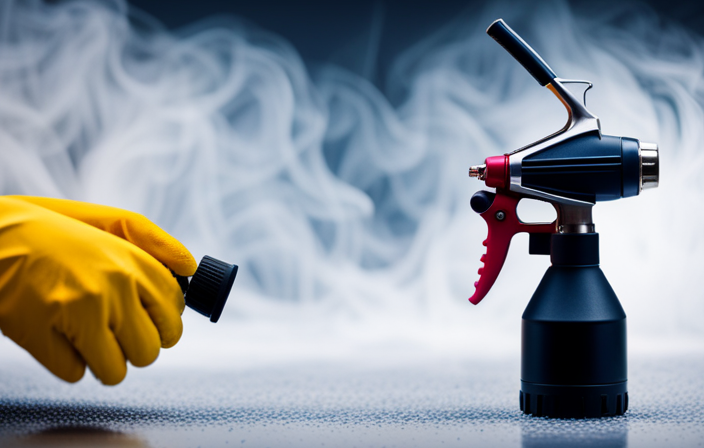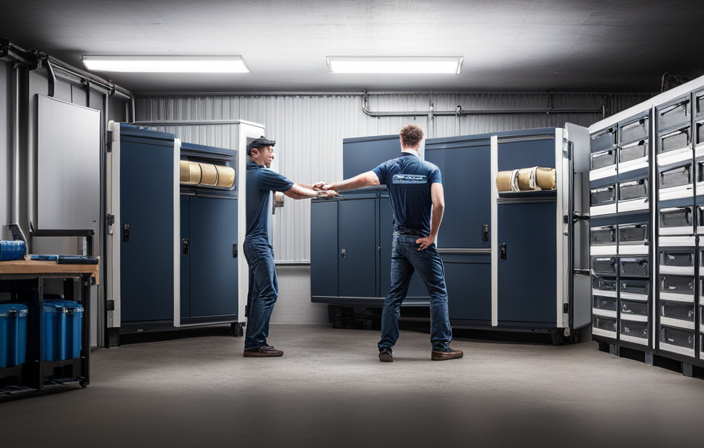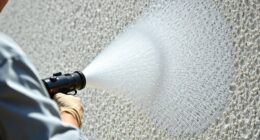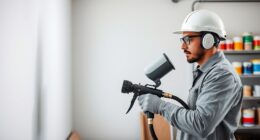Have you ever tried to achieve professional quality results in your painting projects, but struggled with traditional methods? Look no further – the airless paint sprayer is the solution for you.
This powerful tool allows you to effortlessly apply paint with precision and speed, giving your projects a flawless, smooth finish. In this article, I will guide you through the ins and outs of using an airless paint sprayer, from understanding the basics to achieving that showroom-quality result.
We will cover everything from preparing your workspace and materials, to setting up and adjusting the sprayer, to properly priming and applying the paint. I will also share some valuable tips and tricks, as well as safety precautions to keep in mind.
So, if you’re ready to take your painting game to the next level, keep reading and let’s dive into the world of airless paint sprayers.
Key Takeaways
- Regular maintenance is essential for an airless paint sprayer, including cleaning the spray gun after each use and servicing the pump every 3 months.
- Filters should be cleaned or replaced every 5 gallons of paint, and hoses should be inspected and replaced every 6 months.
- The pressure gauge should be checked and calibrated every 12 months to ensure accurate readings.
- Important tips for using an airless paint sprayer include adjusting the pressure for the desired spray pattern, maintaining a consistent distance and motion, and overlapping strokes for even coverage.
Understanding the Basics of an Airless Paint Sprayer
Now that you’ve got your hands on an airless paint sprayer, let’s dive into the basics and get you spraying like a pro! Understanding the Basics of an Airless Paint Sprayer is crucial for achieving a smooth finish and maintaining the sprayer.
To start, regular maintenance is key. Clean the sprayer after each use, making sure to remove any paint residue and unclog any blocked nozzles. Lubricate the moving parts to ensure smooth operation.
Additionally, familiarize yourself with the different techniques for achieving a smooth finish. Keep the sprayer at a consistent distance from the surface, usually around 12-18 inches, and move it at a steady pace. Overlapping each stroke by 50% will prevent streaks.
Finally, ensure that your workspace is well-prepared and your materials are ready for painting. By mastering these basics, you’ll be ready to tackle your next painting project with confidence.
Preparing Your Workspace and Materials
Before starting to use an airless paint sprayer, it’s crucial to clear the area and protect surfaces from any potential overspray or damage.
This involves removing furniture and covering floors, windows, and other objects with drop cloths or plastic sheets.
Additionally, gathering the necessary painting supplies, such as paint, primer, and thinner, is essential to ensure a smooth and efficient painting process.
Clearing the Area and Protecting Surfaces
To ensure a clean and protected work area, it’s important to cover nearby furniture and floors with drop cloths before using the airless paint sprayer. This is one of the key protective measures to prevent accidental paint splatters and spills. Here are three reasons why you should always clear the area and protect surfaces before starting your painting project:
-
Drop cloths not only protect your furniture and floors from paint, but they also make cleanup easier.
-
By clearing the area, you create more space to move around and work comfortably with the paint sprayer.
-
Protecting surfaces ensures that the paint only goes where you intend it to, preventing damage to walls, ceilings, or other objects in the room.
Now that you’ve taken the necessary protective measures and prepared the surfaces, it’s time to move on to gathering the necessary painting supplies.
Gathering the Necessary Painting Supplies
Make sure you gather all the essential supplies you’ll need for your painting project, such as brushes, rollers, and painter’s tape, to ensure a smooth and professional finish.
It is important to have a variety of brushes and rollers to accommodate different surfaces and painting techniques. Brushes with synthetic bristles are ideal for latex paints, while natural bristle brushes work well with oil-based paints. Rollers with different nap lengths are suitable for different surfaces, with shorter naps for smooth surfaces and longer naps for textured surfaces.
Additionally, don’t forget to select the right paint color for your project. Consider the lighting and ambiance of the room you are painting, as well as any existing color schemes.
When you have gathered all the necessary supplies, you can move on to setting up and adjusting the airless paint sprayer, which will be discussed in the next section.
Setting Up and Adjusting the Airless Paint Sprayer
After assembling the airless paint sprayer, it’s crucial to familiarize yourself with the different settings and adjustments. This will ensure that you achieve the desired spray pattern and avoid any potential issues such as nozzle clogs.
To adjust the spray pattern, start by turning the knob on the sprayer’s gun to the desired width. This will determine how wide or narrow the spray will be. Additionally, you can adjust the pressure using the pressure control knob located on the sprayer unit.
If you encounter any nozzle clogs during spraying, simply turn off the sprayer and remove the nozzle. Clean it thoroughly with a nozzle cleaning tool or a small brush before reattaching it. This will help maintain a consistent and smooth spray.
Now, let’s move on to properly priming the sprayer.
Properly Priming the Sprayer
Before you start using the sprayer, it’s essential to prime it properly for optimal performance. Properly priming the airless paint sprayer is crucial to avoid any troubleshooting and ensure smooth operation. Here are the steps to follow for priming the sprayer:
-
Fill the paint container with the desired paint and strain it to remove any impurities.
-
Attach the suction tube to the container and connect it securely to the sprayer.
-
Turn on the sprayer and adjust the pressure according to the paint manufacturer’s recommendations.
-
Hold the sprayer gun over a waste bucket and squeeze the trigger until paint starts flowing smoothly without any air bubbles.
-
Once the sprayer is properly primed, you can proceed to the next step of applying the paint with the airless paint sprayer.
By properly priming the airless paint sprayer, you’ll ensure its longevity and prevent any issues during the painting process. Now, let’s move on to applying the paint with the airless paint sprayer.
Applying the Paint with the Airless Paint Sprayer
Now it’s time to unleash the power of this incredible tool and effortlessly transform your space with a flawless coat of vibrant color. When applying paint with an airless paint sprayer, it’s important to use proper painting techniques and choose the right paint for the job.
To ensure a smooth and even application, hold the sprayer perpendicular to the surface and maintain a consistent distance of 12-18 inches. Start by spraying in a horizontal motion, overlapping each pass by 50%. Then, switch to a vertical motion, again overlapping each pass. This crisscross pattern helps to eliminate any streaks or lines.
When choosing the right paint, consider factors such as the type of surface, desired finish, and durability. Latex paints are commonly used for interior walls, while oil-based paints are more suitable for exteriors and high-traffic areas.
Transitioning into the next section about troubleshooting common issues, it’s important to be aware of potential challenges that may arise during the painting process.
Troubleshooting Common Issues
If you’re experiencing any issues while using the incredible airless paint sprayer, don’t worry – troubleshooting common problems is easier than you think! Here are some troubleshooting tips to help you overcome common problems:
-
Clogging: If the paint is not spraying evenly or the sprayer is clogging, check the paint viscosity and make sure it’s suitable for the sprayer. You may need to thin the paint or use a larger tip size.
-
Low pressure: If the sprayer isn’t producing enough pressure, check the power source and make sure it’s supplying sufficient electricity. Also, inspect the spray tip for any blockages or damage that may be reducing the pressure.
-
Overspray: If you’re experiencing excessive overspray, try adjusting the paint flow rate and pressure settings. Also, ensure that you’re holding the sprayer at the correct distance from the surface.
Now that you know how to troubleshoot common issues, let’s move on to cleaning and maintaining the airless paint sprayer.
Cleaning and Maintaining the Airless Paint Sprayer
To keep your incredible airless paint sprayer in top condition, it’s essential to regularly clean and maintain it. Proper cleaning techniques will ensure that your sprayer performs at its best and extends its lifespan. I recommend following a maintenance schedule to stay on top of this important task. Here is a table to help you understand the different components you need to clean and maintain, along with their recommended cleaning frequency:
| Component | Cleaning Frequency |
|---|---|
| Spray Gun | After each use |
| Pump | Every 3 months |
| Filters | Every 5 gallons |
| Hoses | Every 6 months |
| Pressure Gauge | Every 12 months |
By adhering to this cleaning and maintenance schedule, you can ensure your airless paint sprayer stays in optimal condition. Now, let’s move on to some valuable tips and tricks for using an airless paint sprayer.
Tips and Tricks for Using an Airless Paint Sprayer
Using an airless paint sprayer is like wielding a magic wand, effortlessly transforming your walls with a wave of your hand. To maximize efficiency with an airless sprayer, there are a few techniques to keep in mind.
First, make sure to adjust the pressure to achieve the desired spray pattern. Start with a low pressure setting and gradually increase until you achieve the desired result.
Additionally, maintain a consistent distance from the surface being painted to ensure an even coat. It’s also important to move the sprayer in a smooth, steady motion to avoid streaks or uneven coverage.
Finally, remember to overlap each stroke slightly to avoid missing any areas. By following these airless paint sprayer techniques, you can achieve professional-looking results in no time.
Now, let’s move on to the next section about safety precautions to keep in mind.
Safety Precautions to Keep in Mind
Before you embark on your painting project, it’s crucial to prioritize safety by keeping these precautions in mind.
-
Workplace Safety: Ensure that your work area is well-ventilated to prevent inhalation of paint fumes. Remove any flammable materials from the vicinity and secure the area to avoid accidents.
-
Safety Equipment: Always wear protective gear, including safety goggles, a respirator mask, and gloves, to protect yourself from potential hazards. Additionally, wear appropriate clothing that covers your skin to prevent any contact with paint.
-
Proper Handling: Familiarize yourself with the user manual of the airless paint sprayer to understand its operation and safety features. Use caution when handling the sprayer, ensuring that the trigger is locked when not in use.
By following these safety precautions, you can minimize the risk of accidents and ensure a safe painting experience.
Now, let’s move on to achieving a professional finish with an airless paint sprayer.
Achieving a Professional Finish with an Airless Paint Sprayer
Make sure you focus on achieving a professional finish when using an airless paint sprayer. To achieve the best results, there are a few best practices you should keep in mind.
First, always start by preparing the surface properly, ensuring it’s clean, smooth, and free from any imperfections. This will help the paint adhere better and result in a smoother finish.
Next, choose the right spray tip for the job. Different tip sizes and angles will produce different patterns and coverage, so select the one that suits your project best.
Additionally, maintain a consistent distance between the sprayer and the surface, usually around 12 inches, to ensure even coverage.
Lastly, apply multiple thin coats rather than one thick coat to avoid drips and achieve a more professional look.
By following these steps, you can achieve a flawless, professional paint finish with an airless paint sprayer.
Frequently Asked Questions
Can I use an airless paint sprayer for small touch-up jobs?
Yes, an airless paint sprayer is suitable for small touch-up jobs. To achieve the best results, follow touch-up application techniques and adhere to best practices for small paint jobs, ensuring precise and even coverage.
How do I choose the right tip size for my airless paint sprayer?
To choose the right tip size for your airless paint sprayer, consider the spray pattern control you need. A smaller tip size produces a narrow, concentrated pattern for detailed work, while a larger tip size covers larger areas quickly.
Can I use an airless paint sprayer to apply different types of paint finishes?
Yes, an airless paint sprayer can be used to apply different types of paint finishes. The high pressure from the sprayer atomizes the paint, allowing for a smooth and even application of various finishes such as latex, enamel, or stain.
How do I prevent overspray when using an airless paint sprayer?
To minimize overspray with an airless paint sprayer, follow these tips for controlling overspray: adjust the pressure settings, use a smaller nozzle size, maintain a consistent distance from the surface, and cover surrounding areas with drop cloths or plastic sheeting.
Can I use an airless paint sprayer to paint textured surfaces?
Yes, an airless paint sprayer can be used to paint textured surfaces. However, it is important to use the proper painting techniques and best practices to ensure even coverage and avoid any potential issues.
Conclusion
In conclusion, using an airless paint sprayer is a game-changer when it comes to achieving a professional finish. With its efficient and precise application, you can transform any space into a work of art.
Just remember to follow the steps outlined in this article, from understanding the basics to cleaning and maintaining the sprayer. As the saying goes, "practice makes perfect," so don’t be discouraged if it takes some time to master the technique.
With patience and dedication, you’ll soon be creating masterpieces with your airless paint sprayer.









